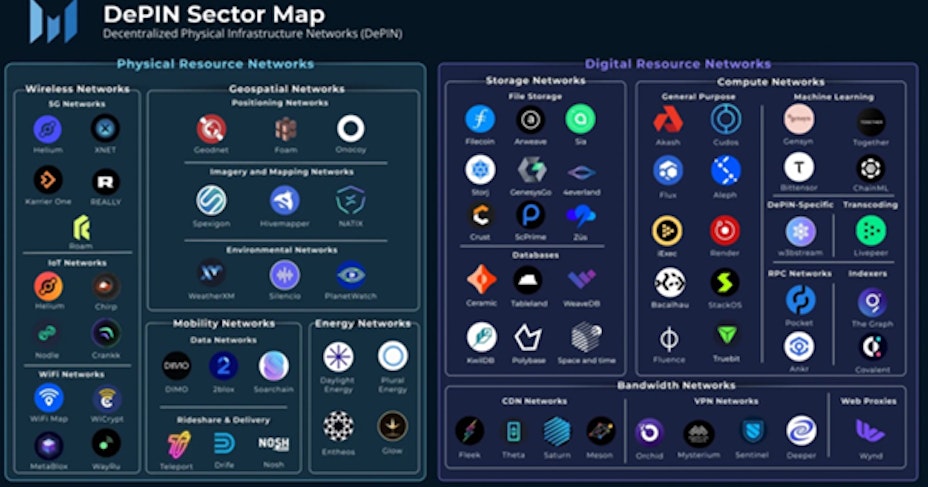What is DePIN - the new hype in crypto
- 15 minute read

DePIN is an abbreviation for Decentralized Physical Infrastructure Networks. It refers to an emerging trend in the world of blockchain and cryptocurrency.
The term itself was coined by blockchain knowledge platform Messari after a vote on X in 2022.
If we dissect the abbreviation we see that they are decentralized physical infrastructure networks. This requires some explanation.
- Since Messari coined the term DePIN in 2022 after a vote on X, this narrative has been on the rise
- DePIN is an acronym of Decentralized Physical Infrastructure Networks
- DePIN aims to be an alternative to centrally managed networks, such as Facebook, Google, and other major players in both physical and digital areas
- This narrative is part of the Web3 revolution, with big names like Filecoin, Bittensor and Render
- ThePIN networks contain both great opportunities and glaring limitations, which must first be overcome
- If DePIN networks pay close attention to simplicity this could become a popular narrative
Inhoudsopgave
- What is DePIN?
- Where does DePIN come from?
- How does DePIN work?
- What is the purpose of DePIN?
- ThePIN networks
- Examples of DePIN networks
- Nice variations of DePIN
- Benefits of DePIN
- Disadvantages of DePIN
- The future of DePIN
What is DePIN?
A lot of physical infrastructure is centralized. For example, a power plant or a data communications center is something you can barely see past. The idea of DePIN is to divide these physical structures into a network of minute pieces maintained by a group of users and blockchain technology.
Nicknames of DePIN include TIPIN (Token Incentivized Physical Infrastructure Networks), PRN (Physical Resource Networks) and PoPW (Proof of Physical Work).
Where does DePIN come from?

It came from outer space. Cyberspace.
It pretty much started late last century with projects that had huge needs for computing power, such as SETI (Search for Extra Terrestrial Intelligence). The aliens have not yet been found, but on Earth they are also still searching for intelligent beings.
This was followed by several projects with the same setup, where people who saw something in a project could have their vain computer contribute computing power to their favorite project. Until blockchains began to see something in it, too.
How does DePIN work?
Suppose you want to replace a centralized network with a physical structure with a decentralized network, where all people can participate to build and maintain this network. What you then need is a place to keep track of all this. You may need to use blockchain technology for this, because it is decentralized by nature. You're already halfway there.
The so-called DePIN flywheel ensures that a circle is formed, with the decentralized physical infrastructure network growing with each lap. As more and more participants join, the token becomes more and more valuable and more investors, users and developers join.
Joining DePIN
The blockchain maintains all the details of a DePIN network. Participation is already possible through the simplest form of DePIN by having a wallet in which the native token can be used. You don't have to give permission for anything to central authorities, such as signing a lengthy legal document that you agree with privacy violations and the like, which no one reads anyway.
Competition with major players
Then data must go into this blockchain to replace or compete with the centralized network. So, for example, if you want to compete with YouTube, there must be a database of all the music ever made. This data will then be provided not by the DePIN network itself or another authority, but by everyone who participates in the DePIN network.
For delivering music files, you will then receive a fee in the form of tokens from the blockchain. The database will grow daily and at some point become a workable alternative to YouTube. Music creators could be compensated with tokens or otherwise for listing or per play.
All of these things still need to be tracked. That is usually done with middleware, say some kind of oracle that keeps track of real time prices and transactions off-chain and offers them to the DePIN blockchain.
What is the purpose of DePIN?
DePIN can replace wealthy parties with a network of users who take charge of setting up, expanding and maintaining it themselves. In this way, you can avoid the system of shareholders, CEOs and dependence on these types of providers.
The era of Web2, which we are currently in the midst of, with huge companies such as Google, Amazon and Facebook, can be seen by DePIN and Web3 be replaced by surrendering power to the community.
The great strength of DePIN lies in using techniques that occur in the everyday lives of citizens. As a result, the scope is enormous and so is the likelihood of success. It is akin to crowdsourcing.
DePIN wants nothing more than to replace centralized with fully decentralized. And that is a very solid ambition! Will this be the new hype in crypto?
Physical resource networks
Physical networks tend to require huge investments. Just imagine the telecommunications network. You then have to break up the road on every street in the country and start laying your cables there. This costs billions. Only very wealthy companies can afford such a thing.
Once the physical network is in place, the cost begins to be determined. The provider naturally wants to recoup his investment as quickly as possible. The profit margin is determined and the consumer often has little choice. With a little luck, he can choose another provider, but that is the same thing.
Abuse of power by large multinationals

Another aspect of the centralized networks is their exorbitant power. They can change their terms to the detriment of others from one day to the next, and then it's take it or leave it. For example, YouTube changed their terms the other day and now you are bombarded to death with advertising unless you want to pay this machine 13 or so dollars a month.
These big companies violate your privacy and sell your data. When a promising startup or successful competitor comes along they buy it or try to compete this other company away. "Don't be evil" from Google was larded with an extra addition: "Unless it pays." Seems like Animal Farm!
Digital resource networks
These networks of digital resources can actually be started right away. You need a good idea and you can immediately encourage participants to join by sharing their digital items with the network, in exchange for native currency.
You can share your bandwidth, excess computing power, surplus energy, basically you can share any unused digital resources with a DePIN network. Of course, the growth of such a network can be much faster than a physical network, which requires investment and technology from the participant.
ThePIN networks
If you go and look at CoinGecko under the heading "Cryptocurrencies" you will see a category there called "DePIN." You can see there that it has already become quite a market. The entire market cap is already 31 billion euros and is currently at spot 18 in terms of narrative, half of which is contributed by the top five. These are well-known names like Filecoin, Render, TheGraph, Theta Network and Arweave.
An overview of the main components of DePIN:

Source: Messari
So you can see that there are two main forms: networks with physical resources and networks with digital resources. The digital networks are the strongest at the moment because this is simply the easiest way to deploy on a blockchain, which is also digital.
Participating in decentralized physical infrastructure networks DePIN
As soon as you have to start working with physical items, such as devices that you have to purchase and set up to participate, the enthusiasm of many people may be gone, unless you own such a thing. For example, a blockchain that requires you to purchase one that costs you hundreds of dollars and also requires you to set it up precisely and keep track of updates has much less potential than a network that you can join almost for free.
Examples of DePIN networks

Filecoin and Arweave
Filecoin and Arweave are data storage networks. They are somewhat reminiscent of Bittorrent's strategy. Network participants provide access to storage space on their hard drive. On it, data is stored forever that can be accessed by others.
Datafiles are broken up into small pieces and sent over the Internet. Users pay a tiny bit cryptocurrency to access a file, a book or song and the like. A part of the file is then sent from several participants and all the particles together form the total file that was requested.
To provide storage capacity, participants receive a bit of the network's native cryptocurrency every time their data is used. Splitting up the files ensures the speed of sending the data, otherwise you'll be waiting an hour for that one user's entire book to be downloaded.
Render
Render is a network that aims to democratize graphic image display. Like Filecoin and Arweave, it is a peer to peer network that primarily displays movies that participants provide, for which they receive the RNDR token.
Users can request images for a small amount of RNDR and can then, for example, watch a movie in high resolution, for which they would otherwise need an expensive GPU. Because these images are not on central servers, no one can take them offline for any reason either.
Generating images costs ever higher resolutions and more expensive equipment, here Render can help at a fraction of the cost.
TheGraph
Many blockchains need real-time statistics to share information with users, such as the price of a cryptocurrency. TheGraph provides charts and real-time information of all kinds of items by coughing it up from various sources.
If you want to know the price of a cryptocurrency, the average price of a range of exchanges must be conjured up so that the prices are exactly right on average. This is obviously very important for all kinds of parties and explains the growing popularity of TheGraph and other so-called oracles.
Theta Network
This platform consists of the Theta Blockchain and Theta Edge Network. It is a peer to peer video streaming network. You can also build dApps on it.
Very big players like Google and Binance participate in this. Broadcasts include footage from NASA, MGM and Lionsgate, while the World Poker Tour, for example, is integrated into Theta TV.
Users are rewarded with Theta tokens for storage and bandwidth, while video and media platforms receive more revenue and have to spend less on their Content Delivery Network.
The technology is very similar to Filecoin, with content delivered in bits by many computers. Theta is fully compatible with Ethereum.
Theta's best use case is to cheaply host and play high-resolution videos that are often otherwise too expensive to play.
Nice variations of DePIN
Hivemapper
This DePIN company wants to compete with Google Maps and other variants.
You buy a dashcam through Hivemapper and install it in your vehicle. This costs about $300 to $700. With this device, you start mapping roads by simply sharing the images with Hivemapper. For this, you get compensation in the form of their native token, $HONEY.
As more people do this, Hivemapper gets a larger and larger portion of all roads on Earth mapped, until the map is complete. The nice thing about this setup is that the map gets updated every day. When there are changes in the road network, Hivemapper is the first to notice.
The price for a dashcam, $300 to $600, is not too expensive for Westerners, but for people in other parts of the world it can be a problem. Therefore, it can take quite a long time to map the poorer parts.
Mapmetrics
This is somewhat similar to Hivemapper, but a driver shares real-time data about road conditions, where the data you share belongs to you and earns you tokens when used.
Your privacy is also paramount on this platform.
IoTeX MachineFi
IoTeX wants to make blockchain and the Internet of Things (IOT) work together. In doing so, they want to use the Web3 revolution to connect the real and digital worlds of smart things. Also known as sensor networks.
Smart things, such as a smart TV or thermostat, can be connected by this platform so that participants share real-world information with this platform and are rewarded with crypto for doing so.
Since this platform works with so-called Real World Assets (RWA), a new and popular narrative in crypto, this could be very big.
One drawback to this technology, however, can be that if your wireless smart modem becomes restless and keeps you from sleeping due to its nightly tumbling on the parquet floor.
Helium
This company wants to build decentralized wireless networks by selling households hotspots to maintain the network. The idea is to connect the entire world through these hotspots and achieve full coverage.
People in the US, meanwhile, can get a connection to Helium for 20$ a month.
First-hand experience with DePIN
I purchased such a hotspot several years ago. For that I had to pay $600 on Coinbase to an unknown company. At that time Helium was worth a lot, around 40 euros.
The delivery time, after many excuses, was about two years. By then, Helium was worth less than 3 euros. I then turned on the hotspot and installed some apps and scavenged about 6 Helium in a year. When they switched to Solana I got no notification at all and it stopped mining.
Apparently I needed to install an update that was untraceable. I then turned off the hotspot and stored it in the closet. These are the dangers of physical DePIN network constructs.
So if something costs a lot and also requires maintenance that is difficult to implement, it can be very detrimental to the network and you should ask yourself whether you should still participate in it.
React Network
The idea behind this is to share locations where batteries have energy left over and supply it in times of energy demand, so that environmentally unfriendly power plants do not have to supply it.
You can connect your smart energy sensor to React and share your excess energy with a regional pool. If there is a regional need for additional energy, React can then provide it. The goal is to centralize energy needs and deliver environmentally friendly energy from the consumer and not through traditional methods of centralized systems.
Bittensor
Wants to be an alternative to centralized players like Google, OpenAI and Amazon in rolling out artificial intelligence. It is a machine learning project, rewarding users in the native token Tao, based on the added value delivered.
Starting up an AI project costs tons of money unless you do it decentralized like Bittensor. If you have the investments and database partially compiled by the user, the cost is many times lower.
Ultimately, Bittensor will be a neural network that AI, crypto and blockchain connects. Through deep learning, the goal here is to create a kind of super brain that can generate efficient and scalable AI calculations and outcomes.
Bittensor is already a very successful coin by now, given its place in CoinGecko.
Silencio
This blockchain attempts to map the world's noise production via microphones that send this data to Silencio for a fee, giving policymakers a noise map of the world to determine if something can be done about noise pollution in specific places.
Benefits of DePIN
- Cheap to start. Since most of the infrastructure and input comes from the participants, it is cheap to start and later scale up as it gets more use.
- Lower (micro) costs for users. Large corporations usually charge much higher (hidden) costs for use of their products.
- Sustainable. All excess resources are used as needed. DePIN stands for little waste.
- Cooperation instead of competition. Everyone looks after this network together and shares in the costs and benefits, collective ownership.
- Fairer. Costs and benefits are shared among participants without intermediaries. Central players keep all benefits themselves.
- Transparency. The blockchain makes all data public, while central networks keep everything hidden except the profit figures.
- Decentralization. This means you are not dependent on the big companies, who can change conditions overnight, such as price and access.
- Adaptability. Where updating Google Maps' world map, for example, takes a lot of time, a company like Hivemapper can do it constantly in real time, without a high cost.
- Building community. Where large companies provide a service, for which you pay anyway, DePIN takes advantage of all participants and gives back to the community what they put in. Everyone is effectively a shareholder, so participants in decentralized networks are motivated and enjoy participating. Participation is permissive.
- Much less cost of decentralized model compared to centralized providers. Central providers have costs such as technicians, support, maintenance, investments and expensive offices.
Disadvantages of DePIN
- Too technical. If DePIN projects and networks saddle ordinary people with relatively heavy tasks, such as keeping up with updates and buying and setting up new equipment, they run the risk of losing users and eventually disappearing again silently. Working with blockchain and cryptocurrencies can also grow over the average citizen's head.
- Costs and benefits. If it costs more to participate than it produces, it is a failing economic model. Even if the benefits are so minimal that it yields very little people will naturally leave.
- Volatility. If people use a DePIN network and have to pay small amounts to do so, that's fine. But if the price of the native token is suddenly worth much more, participation can suddenly become much more expensive and users drop out because of the cost. Some DePIN networks therefore use a coin that can be used with fiat money connected, so that payout remains more or less the same in total.
- Utility function. Many DePIN networks have services that are not widely used. These are doomed as users and providers naturally leave due to disinterest and falling token prices.
- Many users are creatures of habit and use centralized networks like Google Maps because that is what they are used to. The decentralized version can be in cyberspace for years and suddenly emerge or disappear from the map entirely.
- Competing with the big companies like Google, Amazon and Microsoft is a very tough task.
The future of DePIN
DePIN has already made solid inroads. It includes some very successful coins that are high on CoinGecko's list. With a market cap of more than 30 billion, it is no longer a small narrative.
DePIN's prediction is that a number of cryptocurrencies will advance to the top 20 and perhaps higher. It is up to the investor to pick out the winners. Solana looks to become the main home for DePIN platforms.
A blast from the past
Both Helium and Filecoin had very successful beginnings, with network participants making huge profits. It is even claimed that insiders were lining their pockets as best they could in the beginning.
Once the big masses started participating, the earnings went down so much that it became fairly pointless to participate anymore. Especially if you have to buy equipment that is by no means for nothing and has long lead times, because then you can be their additional revenue model.
Everything is about simplicity
The simpler it is to join, the more likely a project is to experience major growth. This can be a problem for many startups because they do not take enough into account the ordinary user, who has little to do with technology and also does not like buying expensive items.
One of DePIN's biggest challenges will be to roll out a working economic model that provides sufficient incentives for businesses, users and participants alike to participate.
It is very difficult to provide something for a small price that will give the participants who need to maintain the network enough to keep participating. If the price is too high, consumers drop out; if the price is too low, participants drop out. The risk of a ponzi scheme is always there.
So with volatility and the bear and bull market in mind, it will be balancing on a tightrope with a machine. Only the best acrobats will succeed.


